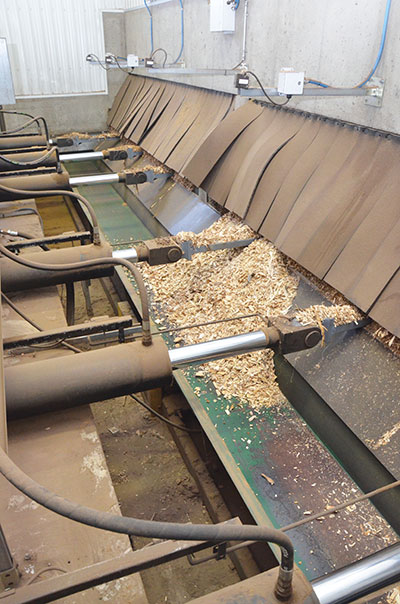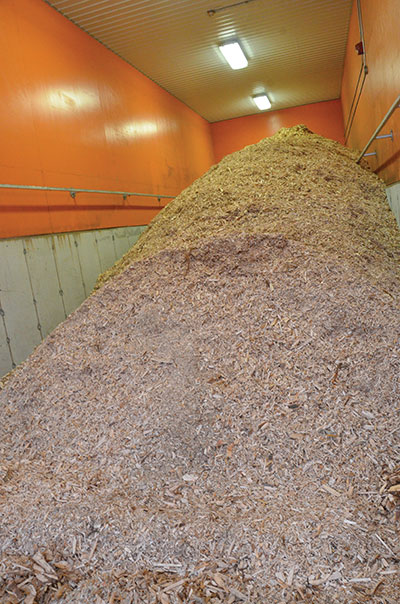
Green energy makes cents
December 13, 2013
By By Guillaume Roy | Translated by Amie Silverwood
How can a business reduce its carbon footprint while investing in long-term development?
How can a business reduce its carbon footprint while investing in long-term development? For Mont-Joli hospital, in the Bas-Saint-Laurent region of Quebec, biomass heating has proven to be the ideal solution that allows administrators to save $200,000 a year and eliminate 2,783 tons of CO2 while contributing to the local economy.
 |
|
| Biomass was an appealing option because it would allow the hospital to support the local economy while taking advantage of available grants.
|
Green energy makes economic sense. Converting from an oil furnace to a biomass boiler worked out well for the health and social services centre at the Mont-Joli hospital.
“The hospital has a long-term vision in mind. Until recently, the hospital was heated with an oil furnace that emitted lots of pollution and greenhouse gases. We asked ourselves if we could do something to improve our carbon footprint. Several options were considered but choosing biomass was the most interesting because there were already local suppliers, it was easy enough to support the local economy by buying from local stock, and the Ministry of Natural Resources and Wildlife through the Energy Efficiency Office (AEEQ), provides grants for these types of projects,” explains Nadia Drapeau, the technical project co-ordinator at the Mitis health and social service centre.
In December 2012, a biomass boiler with 2000 kWh of power installed in a building next to the hospital relieved the building’s reliance on fossil fuels. An electrical furnace allows for heating during maintenance hours. The conversion required $2.3 million, with a $1.1-million grant from AEEQ. The new system will have a five-year payback through annual savings of $234 000. On top of the financial savings biomass technology will provide, 2,783 tons of CO2 emissions will be prevented – an equivalent of taking 1,400 cars off the road each year.
“It’s great to have a long-term plan but it’s even better to make it economically viable,” Drapeau comments.
In order to bring the project from concept to reality, planners took advantage of lessons learned from a similar project in the region. “A biomass boiler at Amqui hospital was already providing heat so we were able to work off their experience and work with Gestion Conseil PMI, who was very supportive in the preparation of our biomass project,” Drapeau explains.
For several years, Gestion Conseil PMI, a green energy consultant based in Amqui, has specialized in biomass heating. The company has developed a solid reputation in this field in Quebec. Among other projects, it worked on the Maria and Montmagny hospitals’ HVAC systems in Quebec’s Causapscal Amqui region.
“Several clients have contacted us to help them convert to biomass since, with the grants, it’s the most economical form of energy,” explains Renaud Sauvard, the manager of the firm. With a $40 grant for each ton of carbon saved over 10 years, it represented more than $1.1 million dollars in grants for the Mont-Joli hospital.
Biomass considerations
In 2011, the Mitis health and social science centre launched a request for proposals for biomass suppliers. “We wanted to know right off the bat about the biomass grades and suppliers that would be viable in our region,” Drapeau recalls. It was the Coopérative forestière de la Matapédia de la St. Florence (CFM) that won the contract to supply 3,000 green metric tons of biomass annually.
News of the hospital’s plans to convert was generally well received but some locals had concerns. “We had a city council meeting. We were asked to explain the project since there were concerns about emissions and pollution coming from the smoke stacks,” says Drapeau. “When we explained that only steam would be emitted and that we were complying with the Ministry of the Environment’s requirements, the project was very well received.” Biomass emission targets are set at 150 mg/m3 of particles while typical residential chimneys produce more than 400 mg/m3.
Combustion Expert took control
It was Combustion Expert, a company based in Trois-Rivières, that won the request for proposals on the design, manufacturing, installation and maintenance of the hospital’s biomass project. The company specializes in biomass heating so it was able to take control of the whole process, except for the manufacturing of the heaters, which was subcontracted by the Groupe Simoneau from Boucherville.
 |
|
| Forty-five tons of biomass can provide four days of heat from the biomass boiler during the coldest days of winter.
|
The model chosen for this product was WX, an industrial-calibre combustion chamber that is able to respond to the hospital’s energy needs, explains Francois Laroche, marketing co-oordinator at Combustion Expert. “This system can make use of greener material. It tolerates up to 58 per cent moisture content without losing efficiency.” The furnace can burn even the greenest biomass, with some loss of efficiency. For the Mont-Joli hospital, CFM delivers biomass that is at a 30 per cent moisture content.
“We’re very proud that the Mont-Joli biomass installation has worked well from the get-go,” Laroche stresses.
Nadia Drapeau agrees that the project was off to a good start from December 2012. Adjustments were necessary only to the frequency of biomass shipments. Two warehouses that hold 45 tons of biomass can provide around four days of heating during the cold winter months while the hospital used to have a reservoir with 113,000 litres of oil that could provide heating for more than a month.
Bas-Saint-Laurent: the future world capital of biomass heating?
Seven major biomass heating projects are already on line in the Bas-Saint-Laurent region of Quebec. If four more projects are realized, the region will have the highest density of biomass heat per square kilometre in the world, according to Renaud Savard, president of Gestion Conseil PMI, a green energy consultant based in Amqui that specializes in biomass heating.
It all started in 2007, when the Coopérative forestière de la Matapédia (CFM) was provided with a grant to build a rural lab to study the viability of woody biomass. “The rural lab allowed us an economical means to secure raw materials. We already worked in the forest, so we were able to integrate it into our operations,” explains Simon Roy, General manager for CFM. It all had to be done from scratch: the harvesting, the skidding and the biomass chipping, he says.
The Amqui hospital pilot project (1,500 green tons) provided the necessary incentive to test the operation from the forest to the burn. “We were able to harvest the biomass and do our testing since we had to deliver a standardized grade, moisture and ash content. We had to meet those objectives economically,” Roy adds.
Since then, a heat network was set up in Causapscal (504 green tons), a boiler room at SEREX, a forest research and wood product expert (115 green tons), and the Coopérative forestière de la Matapédia Ste. Florence (75 green tons). Recently, the boiler at Mont-Joli hospital (3,000 green tons) was installed and several other projects are planned for the near future. The present total of CFM’s deliveries adds up to 5,200 green tons at 35 per cent moisture content annually.
Though CFM currently delivers around 5,000 tons of biomass to its clients annually, “we could easily supply up to 35,000 tons,” Roy says. The company recently purchased a Kesla c645 chipper that can chip 30 tons of wood an hour in the forest or stockyard. “The chip size is easily adjusted, with different screens allowing us better control over the grade of our product,” Roy explains.
Potential biomass investors are patiently awaiting a planned reorganization of the Energy Efficiency Office program that provides funding for the use of woody biomass. This change is expected to take effect in the coming months.
“We’re developing a packaging centre, a consulting firm, engineering offices, a lab and a training centre to create an industrial cluster based on biomass for the region,” Gestion Conseil’s Savard explains. “It should all be in place in four years. It’s great for the region since it will create economic ripples throughout the community.”
Print this page